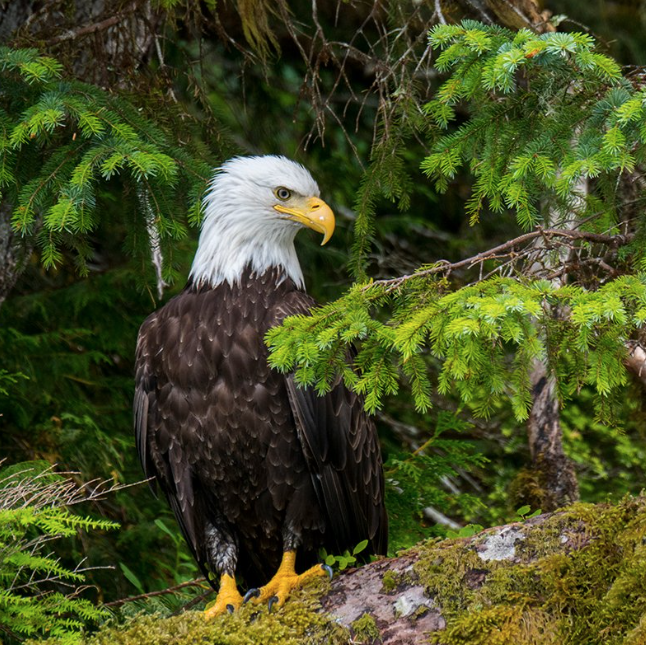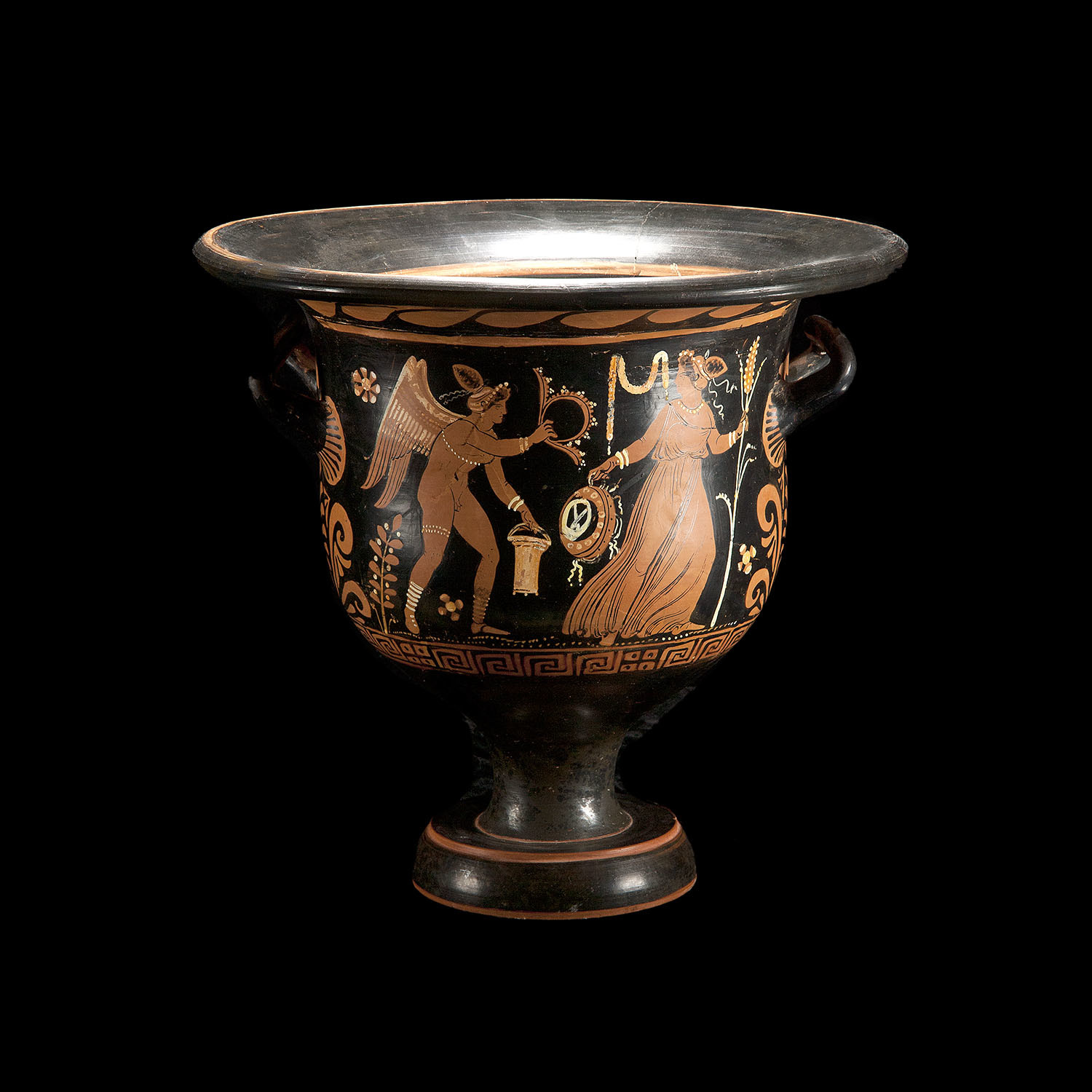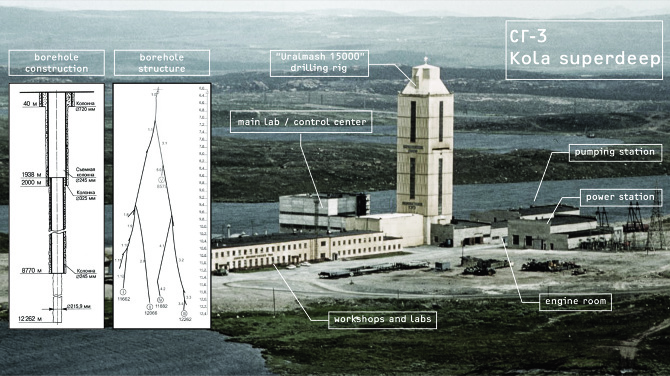Russian Bear
Member
- Jul 21, 2025
- 18
- 1
Kola Superdeep and "Screams from Hell"

Kola Superdeep Borehole
Start of the project
This article is not about space, not about conquering heights, but on the contrary, about how man sought to learn the secrets of the earth's interior. It so happened that this knowledge began at about the same time. 1961, Soviet cosmonaut Yuri Gagarin became the first person in the world to fly into space. The world space race began. A year later, man had already gone into outer space. The cosmonauts, returning, told how wonderful our planet looks from a height of hundreds of kilometers. However, having soared to unattainable early heights, humanity could not penetrate the earth's crust even by a few hundred meters. Gold crawls out of the Earth's mantle, minerals are born there and diamond rivers flow, sometimes breaking through upwards. We will never know what is there, but it was during the Cold War that the only attempt to reach the Earth's mantle was made.
The United States became the first in 1950. A grand project called Mohole was supposed to drill to the mantle near Mexico on the bottom of the Pacific Ocean...
Under the ocean, the crust is the thinnest, the thickness to the mantle is only 20-25 km instead of 80 kilometers on the continents. But underwater drilling is the most expensive - lower the drill to a depth of 4 kilometers, install the rig and drill another twenty kilometers. A lot of money.
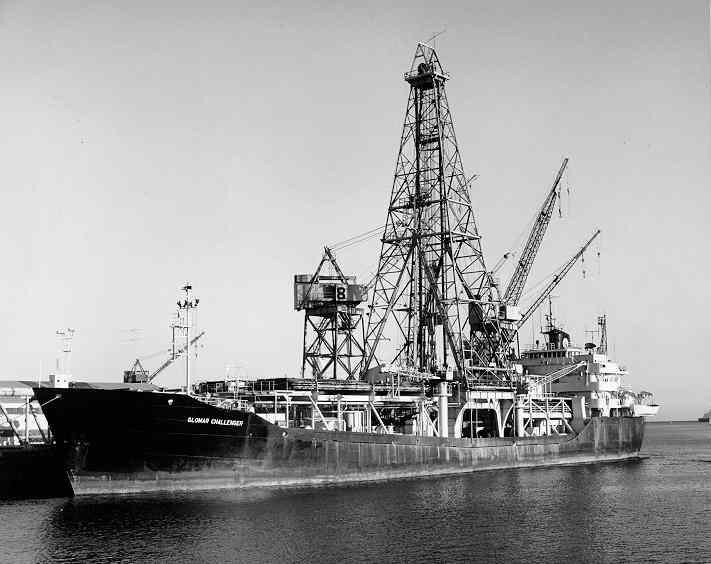
One of the drilling platforms of the closed Mohole project (1968)
And so in 1961, the Americans, temporarily lagging behind the Soviet Union in the space race, decided to head inside the Earth. They decided to drill a well in the Pacific Ocean.
From 1961 to 1966, the Americans tried to implement Mohole. When they made a hole 200 meters deep and extracted ten kilograms of ancient basalt, spending 40 million dollars on it, the US Congress was shocked. And closed the Mohole project because of the insane cost.
So America lost to the Russians. Because in 1970, on the Kola Peninsula, in the wild tundra, the USSR installed a shaft with a giant drill. The drill went down and made its way to the mantle for 20 years. This is how the Kola Superdeep Borehole appeared.
It cost an incredible amount of money, but the USSR was determined to win this underground race for the sake of prestige and all world science. No one knew and knows what is there, in the depths of the Earth, only theories. Such super-deep drilling is equivalent to flying to the stars. It is a journey to nowhere and to no one. A blank sheet and complete uncertainty.
The Russians did not keep waiting long. In the same year, the USSR issued an order to overtake America in deep exploration, to be the first to find out what the earth's crust conceals.
A metallurgical plant was built in the vicinity. They began to mine ore here. The mountains turned into pits. Huge quarries captured areas of hundreds of square kilometers. In the 60s, drillers came here.
The Pechenga region was chosen as one of four places in the Soviet Union where it was decided to drill a well. And not an ordinary one, but a super-deep one. Geophysical exploration reported that it was here that the most ancient rocks were located. A fantastic task was set - to penetrate to a depth of 15 kilometers. And soon the work began to boil.

In 1970, the drill entered the ground, the report began. At that time, no one knew how great the success would be. The work was carried out almost around the clock. The deeper, the harder it was to do. But records followed records. 9 thousand kilometers, 10, 11. In 1989, the Kola borehole was listed in the Guinness Book of Records as the deepest hole in the earth's crust. And the deeper the drill went, the more secrets were revealed. The scientific world was shocked. Geologists from all over the world came to the Kola borehole in the USSR. In 1984, at the height of the Cold War, the cream of world science gathered in a militarized zone to see what the Soviet Kola Superdeep Borehole was. And we showed them. Look, soil raised from a depth of 12 kilometers. It is identical to the moon. And another discovery. The bowels of the planet turn out to be much hotter than theorists assumed, 200 degrees Celsius. And at a depth of 9 thousand meters, the drill entered the compote. This is what geologists call a layer of rock rich in precious metals. A whole belt hundreds of meters thick, consisting entirely of gold, platinum and silver. In a word, sensation after sensation. Scientists then said that there is one scientific discovery for every meter. The fame of the polar geologists spread throughout the world.
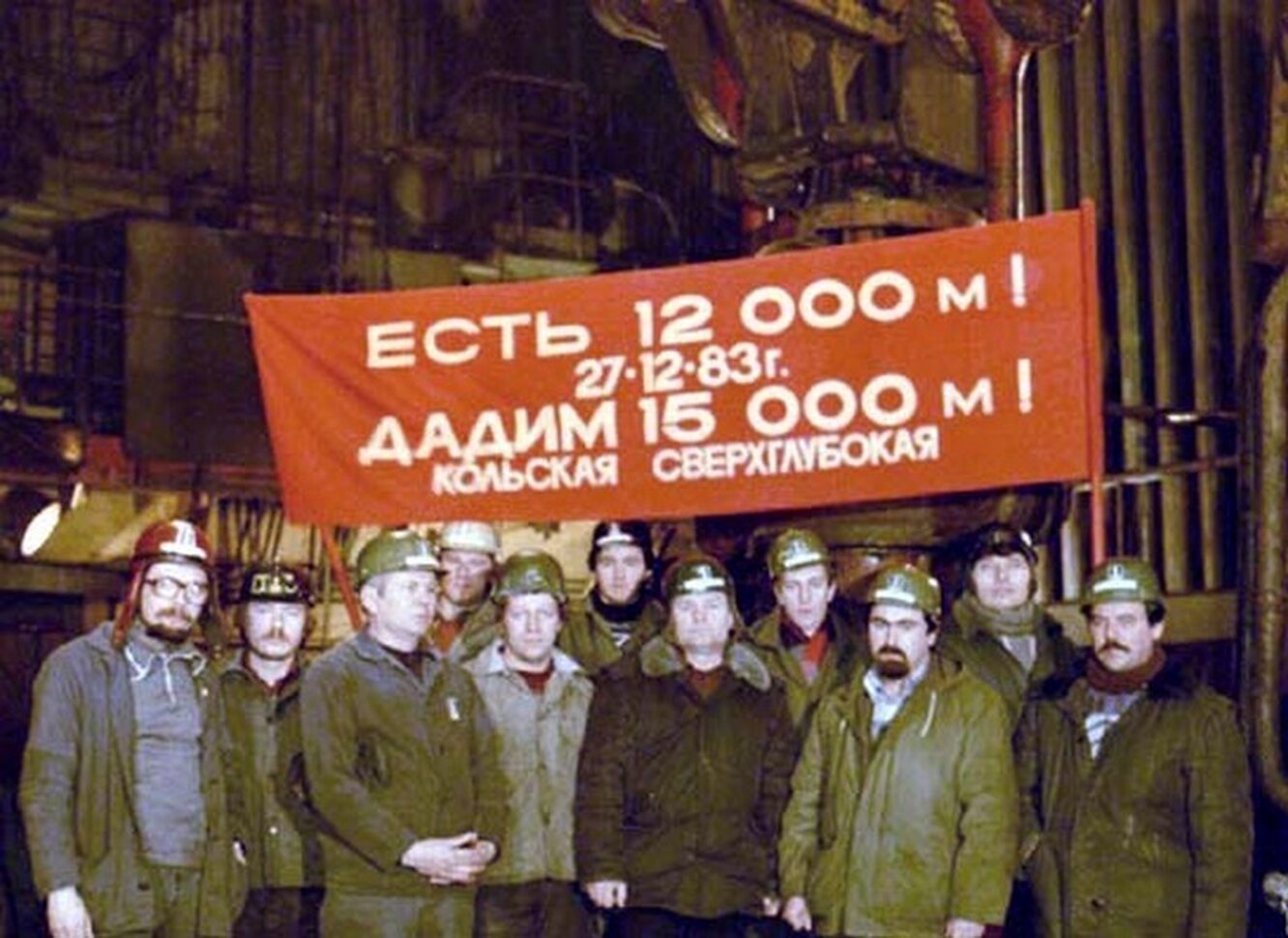
12 kilometers were completed, drilling was becoming increasingly difficult. At the 13th kilometer, accident followed accident.

Sounds of Hell
Having drilled a well to 12,200 meters in 20 years, workers came across empty "rooms" in which the temperature reached 1100 degrees Celsius. Having lowered one of the heat-resistant microphones into one of these holes, they recorded the groans, grinding and screams of a huge number of people. These sounds were called the "voice of the underworld", and the well itself began to be called nothing other than the "road to hell".
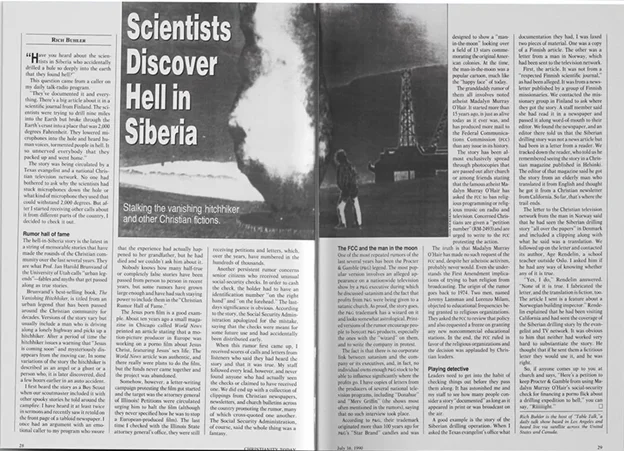
Rumors began to spread among foreign scientists that the Russians had dug up something supernatural at the 13th kilometer, that they had reached the underworld.
Soviet geologists recorded the voices of hell. In 1989, such headlines were on the front pages of all the world's newspapers. They were talking about an ultra-deep drilling rig on the Kola Peninsula.
The most interesting thing is that the engineer-geologist Dmitry Azzakov disappeared just a few months after the work was stopped. And it was he who made an audio recording of the eerie sounds coming from the well.
In the only interview that Azzakov gave to the newspaper in 1989, the man said the following:
- The drill, having reached a depth of 12,250 meters, began to spin wildly and easily descend, as if it had reached a large void inside the Earth. We stopped the work and lowered a geodetic thermometer there, which showed 1100 °C, and then simply turned off. After that, we lowered a super-sensitive microphone into this abyss (to listen to the movement of the plates). That's how these sounds of Hell were recorded...
Sounds of Hell recorded at the Kola Superdeep:
What the scientists heard really scared them: terrible and grinding screams, as if emitted by a desperate, exhausted human crowd. According to Azzakov, this was the real reason for stopping the drilling. Everyone was so horrified that they sealed the hole and quickly left this place. Also, the main coincidence is that the collapse of the USSR stopped funding this project.

The cover of the Kola Superdeep Borehole Location on the map: https://www.google.com/maps/place/K...try=ttu&g_ep=EgoyMDI1MDYxNy4wIKXMDSoASAFQAw==
Moreover, this story was indirectly confirmed by the project manager, David Guberman, who is, by the way, an honored geologist of the RSFSR and a doctor of technical sciences:
- When I am asked about this mysterious story, I do not know what to answer. On the one hand, stories about a "demon" are nonsense. On the other hand, as an honest scientist, I cannot say that I know what exactly happened to us. Indeed, a very strange noise was recorded, then there was an explosion... A few days later, nothing like this was found at the same depth.
Project manager Azzakov says:
"As a communist, I don't believe in Heaven or the Bible, but as a scientist, I now believe in hell. Needless to say, we were truly shocked to make such a discovery.
We lowered a microphone into the borehole to record the sound of the lithospheric plates moving. But instead of the plates moving, we heard a screaming human voice, in which there was pain. At first, we thought that the sound was made by our own drilling equipment.
But then, when we adjusted the equipment again, our worst suspicions were confirmed. The screams and cries were not the screams and wails of one person, they were the screams, cries and groans of millions of people."
The audio about the screams from hell lasts exactly 40 seconds, and how much pain and suffering fit into these seconds..
Whether you believe it or not is up to you.

Soviet poster worker and peasant woman

Kola Superdeep Borehole
Start of the project
This article is not about space, not about conquering heights, but on the contrary, about how man sought to learn the secrets of the earth's interior. It so happened that this knowledge began at about the same time. 1961, Soviet cosmonaut Yuri Gagarin became the first person in the world to fly into space. The world space race began. A year later, man had already gone into outer space. The cosmonauts, returning, told how wonderful our planet looks from a height of hundreds of kilometers. However, having soared to unattainable early heights, humanity could not penetrate the earth's crust even by a few hundred meters. Gold crawls out of the Earth's mantle, minerals are born there and diamond rivers flow, sometimes breaking through upwards. We will never know what is there, but it was during the Cold War that the only attempt to reach the Earth's mantle was made.
The United States became the first in 1950. A grand project called Mohole was supposed to drill to the mantle near Mexico on the bottom of the Pacific Ocean...
Under the ocean, the crust is the thinnest, the thickness to the mantle is only 20-25 km instead of 80 kilometers on the continents. But underwater drilling is the most expensive - lower the drill to a depth of 4 kilometers, install the rig and drill another twenty kilometers. A lot of money.
One of the drilling platforms of the closed Mohole project (1968)
And so in 1961, the Americans, temporarily lagging behind the Soviet Union in the space race, decided to head inside the Earth. They decided to drill a well in the Pacific Ocean.
From 1961 to 1966, the Americans tried to implement Mohole. When they made a hole 200 meters deep and extracted ten kilograms of ancient basalt, spending 40 million dollars on it, the US Congress was shocked. And closed the Mohole project because of the insane cost.
So America lost to the Russians. Because in 1970, on the Kola Peninsula, in the wild tundra, the USSR installed a shaft with a giant drill. The drill went down and made its way to the mantle for 20 years. This is how the Kola Superdeep Borehole appeared.
It cost an incredible amount of money, but the USSR was determined to win this underground race for the sake of prestige and all world science. No one knew and knows what is there, in the depths of the Earth, only theories. Such super-deep drilling is equivalent to flying to the stars. It is a journey to nowhere and to no one. A blank sheet and complete uncertainty.
The Russians did not keep waiting long. In the same year, the USSR issued an order to overtake America in deep exploration, to be the first to find out what the earth's crust conceals.
A metallurgical plant was built in the vicinity. They began to mine ore here. The mountains turned into pits. Huge quarries captured areas of hundreds of square kilometers. In the 60s, drillers came here.
The Pechenga region was chosen as one of four places in the Soviet Union where it was decided to drill a well. And not an ordinary one, but a super-deep one. Geophysical exploration reported that it was here that the most ancient rocks were located. A fantastic task was set - to penetrate to a depth of 15 kilometers. And soon the work began to boil.
In 1970, the drill entered the ground, the report began. At that time, no one knew how great the success would be. The work was carried out almost around the clock. The deeper, the harder it was to do. But records followed records. 9 thousand kilometers, 10, 11. In 1989, the Kola borehole was listed in the Guinness Book of Records as the deepest hole in the earth's crust. And the deeper the drill went, the more secrets were revealed. The scientific world was shocked. Geologists from all over the world came to the Kola borehole in the USSR. In 1984, at the height of the Cold War, the cream of world science gathered in a militarized zone to see what the Soviet Kola Superdeep Borehole was. And we showed them. Look, soil raised from a depth of 12 kilometers. It is identical to the moon. And another discovery. The bowels of the planet turn out to be much hotter than theorists assumed, 200 degrees Celsius. And at a depth of 9 thousand meters, the drill entered the compote. This is what geologists call a layer of rock rich in precious metals. A whole belt hundreds of meters thick, consisting entirely of gold, platinum and silver. In a word, sensation after sensation. Scientists then said that there is one scientific discovery for every meter. The fame of the polar geologists spread throughout the world.

12 kilometers were completed, drilling was becoming increasingly difficult. At the 13th kilometer, accident followed accident.
Sounds of Hell
Having drilled a well to 12,200 meters in 20 years, workers came across empty "rooms" in which the temperature reached 1100 degrees Celsius. Having lowered one of the heat-resistant microphones into one of these holes, they recorded the groans, grinding and screams of a huge number of people. These sounds were called the "voice of the underworld", and the well itself began to be called nothing other than the "road to hell".

Rumors began to spread among foreign scientists that the Russians had dug up something supernatural at the 13th kilometer, that they had reached the underworld.
Soviet geologists recorded the voices of hell. In 1989, such headlines were on the front pages of all the world's newspapers. They were talking about an ultra-deep drilling rig on the Kola Peninsula.
The most interesting thing is that the engineer-geologist Dmitry Azzakov disappeared just a few months after the work was stopped. And it was he who made an audio recording of the eerie sounds coming from the well.
In the only interview that Azzakov gave to the newspaper in 1989, the man said the following:
- The drill, having reached a depth of 12,250 meters, began to spin wildly and easily descend, as if it had reached a large void inside the Earth. We stopped the work and lowered a geodetic thermometer there, which showed 1100 °C, and then simply turned off. After that, we lowered a super-sensitive microphone into this abyss (to listen to the movement of the plates). That's how these sounds of Hell were recorded...
Sounds of Hell recorded at the Kola Superdeep:
What the scientists heard really scared them: terrible and grinding screams, as if emitted by a desperate, exhausted human crowd. According to Azzakov, this was the real reason for stopping the drilling. Everyone was so horrified that they sealed the hole and quickly left this place. Also, the main coincidence is that the collapse of the USSR stopped funding this project.
The cover of the Kola Superdeep Borehole Location on the map: https://www.google.com/maps/place/K...try=ttu&g_ep=EgoyMDI1MDYxNy4wIKXMDSoASAFQAw==
Moreover, this story was indirectly confirmed by the project manager, David Guberman, who is, by the way, an honored geologist of the RSFSR and a doctor of technical sciences:
- When I am asked about this mysterious story, I do not know what to answer. On the one hand, stories about a "demon" are nonsense. On the other hand, as an honest scientist, I cannot say that I know what exactly happened to us. Indeed, a very strange noise was recorded, then there was an explosion... A few days later, nothing like this was found at the same depth.
Project manager Azzakov says:
"As a communist, I don't believe in Heaven or the Bible, but as a scientist, I now believe in hell. Needless to say, we were truly shocked to make such a discovery.
We lowered a microphone into the borehole to record the sound of the lithospheric plates moving. But instead of the plates moving, we heard a screaming human voice, in which there was pain. At first, we thought that the sound was made by our own drilling equipment.
But then, when we adjusted the equipment again, our worst suspicions were confirmed. The screams and cries were not the screams and wails of one person, they were the screams, cries and groans of millions of people."
The audio about the screams from hell lasts exactly 40 seconds, and how much pain and suffering fit into these seconds..
Whether you believe it or not is up to you.

Soviet poster worker and peasant woman



